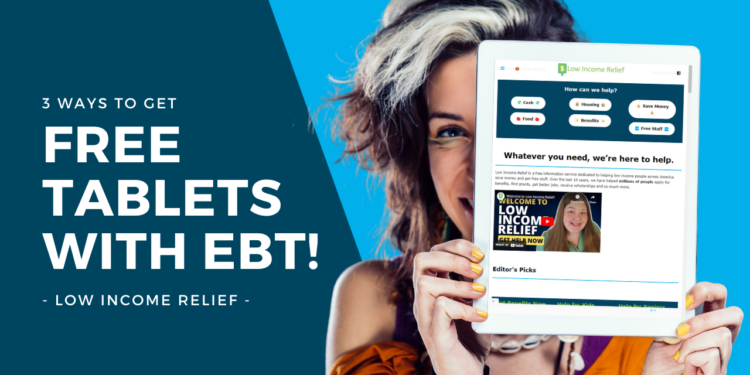Introduction
In an increasingly digital world, access to the internet and technology has become essential for education, job opportunities, healthcare, and daily communication. However, not everyone has equal access to these tools, creating what is often referred to as the “digital divide.” To address this issue and promote digital inclusion, initiatives have emerged to provide free tablets to individuals and families receiving assistance through the Electronic Benefit Transfer (EBT) program. In this article, we will explore the concept of free tablets with EBT, the significance of such programs, and the potential impact on bridging the digital divide.
Understanding the Digital Divide
The digital divide refers to the gap that exists between those who have access to the internet and digital technologies and those who do not. This divide can be attributed to various factors, including socioeconomic status, geographical location, age, and educational background. Those on the wrong side of the digital divide often face significant challenges:
- Limited Educational Opportunities: Lack of access to the internet and digital devices can hinder students’ ability to engage in online learning and access educational resources.
- Reduced Employment Opportunities: Many job applications and training programs are now online, making it difficult for individuals without internet access to find employment or develop new skills.
- Limited Access to Healthcare: Telemedicine and online health resources have become crucial, particularly during the COVID-19 pandemic. Those without digital access may struggle to receive necessary healthcare services.
- Social Isolation: Digital exclusion can lead to social isolation, as many social activities and connections have moved online.
- Inequities in Information Access: Lack of internet access can result in inequities in accessing critical information, such as news, government services, and emergency alerts.
Free Tablets with EBT: A Solution to the Digital Divide
Recognizing the importance of addressing the digital divide, some initiatives and programs have emerged to provide free tablets to individuals and families who receive assistance through the Electronic Benefit Transfer (EBT) program. EBT is a federal program that helps low-income individuals and families access essential food and nutrition resources, such as the Supplemental Nutrition Assistance Program (SNAP), formerly known as food stamps.
These programs leverage partnerships between government agencies, nonprofit organizations, and private companies to distribute tablets to EBT recipients. Here’s how they work:
- Eligibility: Participants in these programs are typically required to be EBT cardholders, which indicates their eligibility for government assistance.
- Application Process: Eligible individuals or families can apply for a free tablet through a designated website or application process.
- Distribution: Once approved, the tablets are distributed to recipients, either through direct delivery to their homes or designated pickup locations.
- Digital Literacy Training: Some programs also offer digital literacy training to help recipients maximize the benefits of their new tablets and access online resources effectively.
Significance of Free Tablets with EBT Programs
The provision of free tablets with EBT holds significant importance for several reasons:
- Promoting Digital Inclusion: These programs take a proactive approach to addressing the digital divide, ensuring that low-income individuals and families have access to essential digital tools.
- Enhancing Educational Opportunities: Access to a tablet opens up educational opportunities, allowing students to participate in online learning, complete assignments, and access educational resources.
- Improving Employment Prospects: With a tablet, job seekers can search for employment opportunities, submit job applications, and access online training and job placement services.
- Enabling Access to Healthcare: Tablets facilitate telemedicine appointments, access to health-related information, and the ability to manage healthcare appointments and prescriptions online.
- Strengthening Communities: By providing digital access, these programs help individuals connect with their communities, access government services, and stay informed about local events and resources.
- Mitigating the Impact of Social Isolation: Digital access can combat social isolation by enabling individuals to connect with friends and family through video calls and social media.
Challenges and Considerations
While free tablets with EBT programs offer numerous benefits, there are also challenges and considerations to address:
- Internet Access: A tablet alone does not provide internet access. Ensuring that recipients have affordable and reliable internet access is critical.
- Digital Literacy: Some recipients may have limited digital literacy skills, requiring additional support and training to effectively use their tablets.
- Maintenance and Upkeep: Tablets may require maintenance and software updates, which could pose challenges for some recipients.
- Data Privacy: Safeguarding user data and privacy is essential, particularly when providing tablets to vulnerable populations.
- Sustainability: Ensuring the long-term sustainability of these programs requires ongoing funding and partnerships.
Conclusion
Free tablets with EBT programs represent a significant step toward bridging the digital divide and promoting digital inclusion among low-income individuals and families. By providing access to essential digital tools, these initiatives empower recipients to access education, employment opportunities, healthcare services, and more.
However, addressing the digital divide is a multifaceted challenge that goes beyond providing hardware. Ensuring affordable internet access, offering digital literacy training, and addressing privacy concerns are all critical components of a comprehensive solution.
As technology continues to advance and the digital landscape evolves, these programs have the potential to make a meaningful impact in narrowing the digital divide, fostering greater equity, and improving the overall quality of life for EBT recipients and their communities.






